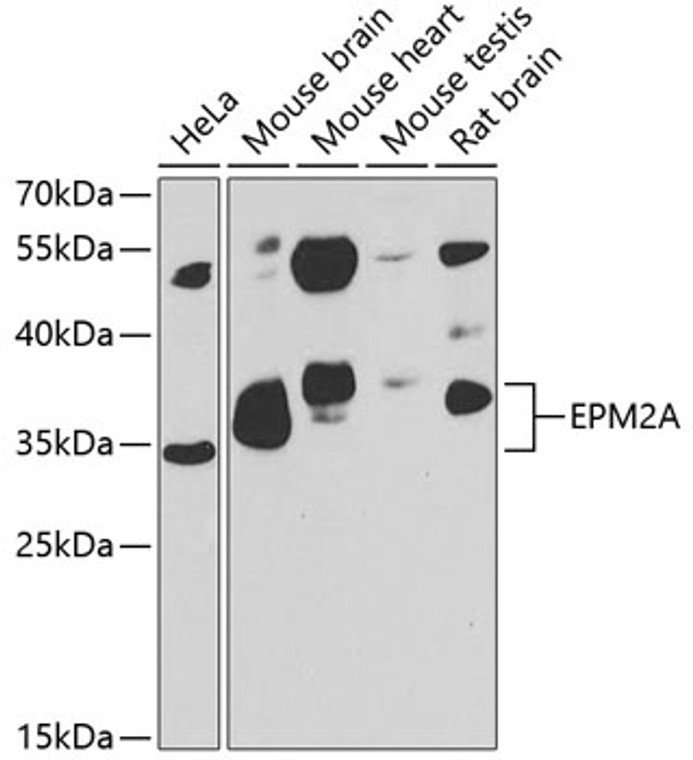| Host: |
Rabbit |
| Applications: |
WB |
| Reactivity: |
Human/Mouse/Rat |
| Note: |
STRICTLY FOR FURTHER SCIENTIFIC RESEARCH USE ONLY (RUO). MUST NOT TO BE USED IN DIAGNOSTIC OR THERAPEUTIC APPLICATIONS. |
| Short Description: |
Rabbit polyclonal antibody anti-EPM2A (244-331) is suitable for use in Western Blot research applications. |
| Clonality: |
Polyclonal |
| Conjugation: |
Unconjugated |
| Isotype: |
IgG |
| Formulation: |
PBS with 0.02% Sodium Azide, 50% Glycerol, pH7.3. |
| Purification: |
Affinity purification |
| Dilution Range: |
WB 1:500-1:2000 |
| Storage Instruction: |
Store at-20°C for up to 1 year from the date of receipt, and avoid repeat freeze-thaw cycles. |
| Gene Symbol: |
EPM2A |
| Gene ID: |
7957 |
| Uniprot ID: |
EPM2A_HUMAN |
| Immunogen Region: |
244-331 |
| Immunogen: |
Recombinant fusion protein containing a sequence corresponding to amino acids 244-331 of human EPM2A (NP_005661.1). |
| Immunogen Sequence: |
MLPQAVCLLHALLEKGHIVY VHCNAGVGRSTAAVCGWLQY VMGWNLRKVQYFLMAKRPAV YIDEEALARAQEDFFQKFGK VRSSVCSL |
| Tissue Specificity | Expressed in heart, skeletal muscle, kidney, pancreas and brain. Isoform 4 is also expressed in the placenta. |
| Post Translational Modifications | Polyubiquitinated by NHLRC1/malin. Phosphorylation on Ser-25 by AMPK affects the phosphatase activity of the enzyme and its ability to homodimerize and interact with NHLRC1, PPP1R3C or PRKAA2. |
| Function | Plays an important role in preventing glycogen hyperphosphorylation and the formation of insoluble aggregates, via its activity as glycogen phosphatase, and by promoting the ubiquitination of proteins involved in glycogen metabolism via its interaction with the E3 ubiquitin ligase NHLRC1/malin. Shows strong phosphatase activity towards complex carbohydrates in vitro, avoiding glycogen hyperphosphorylation which is associated with reduced branching and formation of insoluble aggregates. Dephosphorylates phosphotyrosine and synthetic substrates, such as para-nitrophenylphosphate (pNPP), and has low activity with phosphoserine and phosphothreonine substrates (in vitro). Has been shown to dephosphorylate MAPT. Forms a complex with NHLRC1/malin and HSP70, which suppresses the cellular toxicity of misfolded proteins by promoting their degradation through the ubiquitin-proteasome system (UPS). Acts as a scaffold protein to facilitate PPP1R3C/PTG ubiquitination by NHLRC1/malin. Also promotes proteasome-independent protein degradation through the macroautophagy pathway. Isoform 2: Does not bind to glycogen. Lacks phosphatase activity and might function as a dominant-negative regulator for the phosphatase activity of isoform 1 and isoform 7. Isoform 7: Has phosphatase activity (in vitro). |
| Protein Name | Laforin Glucan PhosphataseGlycogen PhosphataseLafora PtpaseLafptpase |
| Database Links | Reactome: R-HSA-3322077Reactome: R-HSA-3785653 |
| Cellular Localisation | CytoplasmUnder Glycogenolytic Conditions Localizes To The NucleusIsoform 1: CytoplasmEndoplasmic Reticulum MembranePeripheral Membrane ProteinCytoplasmic SideCell MembraneColocalizes With Glycogen Synthase In Punctate Structures In The CytoplasmPrimarily Associated With Polyribosomes At The Rough Endoplasmic ReticulumAnd Also Detected At The Plasma MembraneIsoform 2: CytoplasmNucleusAlso Found In The NucleusIsoform 4: CytoplasmIsoform 5: CytoplasmIsoform 7: Cytoplasm |
| Alternative Antibody Names | Anti-Laforin antibodyAnti-Glucan Phosphatase antibodyAnti-Glycogen Phosphatase antibodyAnti-Lafora Ptpase antibodyAnti-Lafptpase antibodyAnti-EPM2A antibody |
Information sourced from Uniprot.org
12 months for antibodies. 6 months for ELISA Kits. Please see website T&Cs for further guidance







